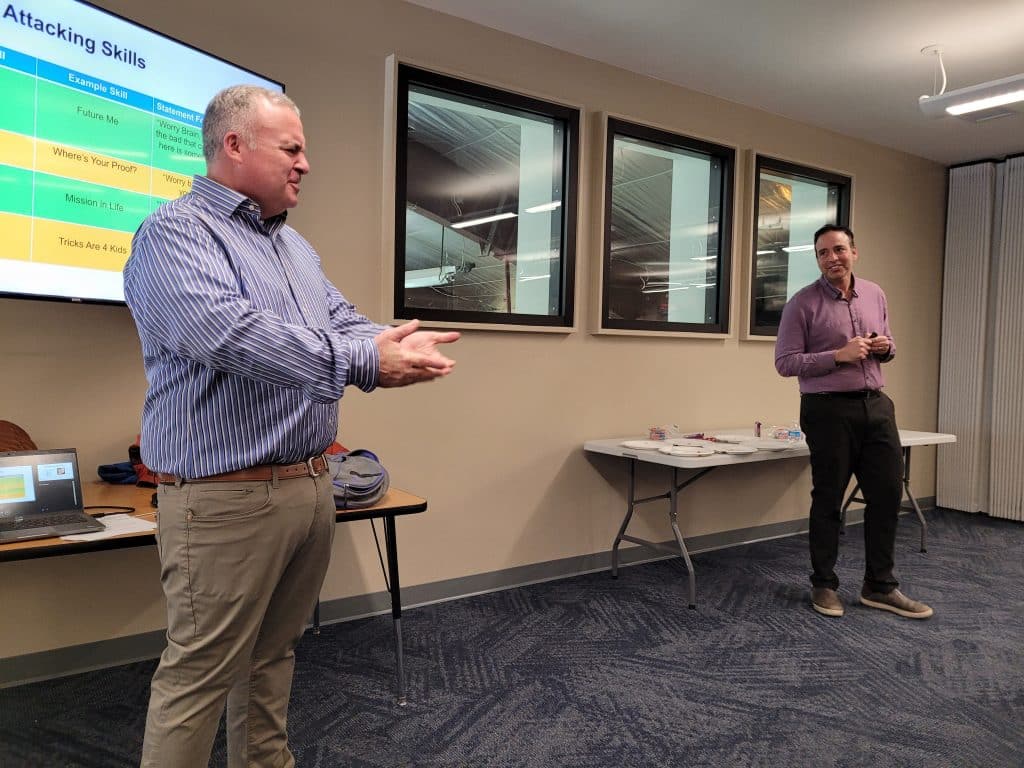
Suzie Romig/Steamboat Pilot & Today
Each of the approximately 85 parents, educators and community members who filled the large meeting room at Howelsen Ice Arena sat holding a small jelly bean in their hands.
Educator Scott Cypers, Ph.D., asked attendees how anxious they felt to eat the jelly bean that could taste of either barf or peach, spoiled milk or coconut, and liver and onions or cappuccino.
The hands-on lesson, whether terrible or tasty, provided an illustration of how parents can help children learn to attack anxiety, a health issue that has plagued more youth post-pandemic. The jelly bean challenge represented a small step in exposure therapy.
“Anxiety does not decrease until the exposure phase begins,” Cypers explained. “When we avoid, we don’t learn the skills we need to be successful with this in the future.”
Unlike fear of a real threat, anxiety is the anticipation of a future threat that leads to vigilant and avoidant behaviors. Anxiety disorders differ from developmentally normal fears by being excessive, persisting longer than six months and causing problems with daily life functions.
Cypers, director of stress and anxiety programs at the CU Anschutz Department of Psychiatry, encouraged parents to learn and teach their children the F-A-C-E method to face their anxiety, which he explained during two well-attended presentations on Tuesday, Dec. 6, hosted by the Steamboat Springs School District.
F stands for “feeling anxious.” What is your level of anxiety for this challenge, and do you need a calming tool or to focus on your smart brain to take this step?

Suzie Romig/Steamboat Pilot & Today
A stands for “acknowledge and attack your worry brain.” Challenge the validity of those anxious worries with the smart portion of your brain.
C stands for “charge ahead by using the right battle skills.” What tools would help you overcome the anxiety, such as problem solving, scenario rehearsal, courage or breaking the task down into smaller steps.
E stands for “evaluate and enhance motivation.” Was your anxiety correct, or did you survive eating the jelly bean and could do it again?
Shelby DeWolfe, SSSD behavioral health and restorative practices coordinator, asked Cypers and colleague Aaron Ragon, a licensed therapist and adjunct professor at University of Denver, to present in Steamboat due to the prevalence of youth anxiety and depression.
School officials know mental health challenges increased during the COVID-19 pandemic, but results from the Healthy Kids Colorado Survey completed in 2021 by middle and high school students emphasized those concerns, DeWolfe said. Leaders from Children’s Hospital Colorado declared a youth mental health state of emergency in May 2021.
The survey showed 27% of local high school students think their stress level is not manageable most days. More than 64% said they had poor mental health during the pandemic. Approximately 33% were sad or hopeless almost every day for two or more weeks in the past 12 months. Approximately 28% purposely hurt themselves, without wanting to die, in the past 12 months that can range from pulling their hair to cutting or burning their skin, DeWolfe said.
Survey results from middle school students in the district also pointed to increased anxiety.
“Behavioral health needs in Colorado have always been great, and there have been challenges in adequately meeting the needs. Increased demand for behavioral health services due to the events of 2020, including social upheaval and COVID-19, further exposed gaps and challenges,” DeWolfe said.

Suzie Romig/Steamboat Pilot & Today
The current YouthRoots Routt County leadership group for high school students also identified mental health, anxiety and depression as important community concerns for youth.
“We have increased our mental health providers but are still understaffed, and most of the positions are grant funded,” DeWolfe said. “The district is constantly looking at creative ways to address this and find sustainable, high-quality providers who are culturally competent and can serve diverse needs and diverse populations in our community.”
The anxiety educators said studies show 12% of elementary children and about 11% of adolescents have some type of anxiety disorder, which commonly manifest as school truancy, regular visits to the nurse’s office or missed class time. Cypers teaches parents that anxiety can mimic stomachaches, so his rule of thumb is children with anxiety issues should not be allowed to miss school unless they are running a fever.
Cypers suffered from anxiety as a youth but was not provided proper tools to combat the issue, so he dedicated his life to developing tools. He said avoidance or long-term accommodations without learning coping mechanisms can lead to running from anxiety without learning to habituate and then master anxiety.
Just as parents would not start their children skiing on a double black run, battling anxiety needs to start as skiing starts with trying out equipment, practicing with those tools and then tackling the bunny slopes of anxiety.
“The way we get the anxiety alarm to stop controlling us around our psychological fears is by doing what it is afraid of and teaching our worry brains we can handle it,” Cypers explained. “The more we keep doing, the more our alarm learns we can handle the situation and stops firing. Fighting anxiety is a lot like learning to swim or ski.”
To reach Suzie Romig, call 970-871-4205 or email sromig@SteamboatPilot.com.

